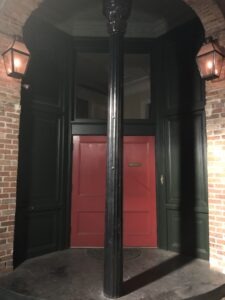In New Orleans’ French Quarter, there is a stately home that is often a stop on walking tours. According to local legend, this house was once the residence of an immortal vampire. In the early 20th century, this charismatic figure entertained high society while surreptitiously feeding on the city’s citizens. Some say he was the famed Count of St. Germain, who had charmed the courts of Europe in centuries past.
The Legend
As the story goes, in the early 1900s (1902 – 1904 depending on the source), a wealthy, middle-aged man by the name of Jacques St. Germain moved to New Orleans from France. He took up residence at a house on Royal St. and began throwing lavish parties for the city’s elite. He treated his guests to fine meals, but curiously would never partake himself. This mysterious host was only ever seen drinking what was assumed to be red wine.
St. Germain also regaled his guests with stories of ancient times that were so detailed; it was as if he had been there himself. He claimed to be a descendant of the Count of St. Germain, who was a famed 18th century adventurer, musician, and alchemist, among other things. Guests noted the physical resemblance between their host and portraits of the count. Some began to wonder if Jacques St. Germain was, in fact, the same man as the Count of St. Germain known to history.
Jacques St. Germain’s charm and enigmatic nature gained him quite a reputation in the city. However, everything changed one November evening when an injured woman was found in the street in front of St. Germain’s house. At first, people assumed she had fallen from the second floor balcony. However, it quickly became apparent that she jumped. The police were summoned and, before being taken to the hospital, the women shared a shocking tale.
St. Germain had apparently invited this woman into his home. Some believe she may have been a prostitute. While she was looking over objects on his mantle, St. Germain lunged at her and bit her neck. As he was attacking her, a knocking at the front door momentarily distracted him. This gave her the opportunity to escape his grasp and jump off the balcony to the street below.
After hearing this accusation, the police then spoke to St. Germain. He assured them that he had made no such attack. Given the late hour, they agreed that St. Germain would visit the station the next morning to give his formal statement. The officers apparently didn’t believe the woman’s account and were inclined to trust St. Germain due to his wealth and standing in the community. This decision, however, turned out to be a mistake.
The next day, St. Germain did not appear at the station. The police returned to his house to retrieve him, but no one answered the door. They eventually had to break in and were shocked at the state of things. Most of St. Germain’s belongings were gone. He had apparently departed the previous night after the incident. As the police looked around, they saw bloodstains on the tablecloths and carpets. No food, dinnerware, or utensils were in the house. They did find a number of corked wine bottles. However, upon opening some, they realized the bottles were filled with a mixture of wine and blood! No one knows where Jacques St. Germain fled to, but the police were never able to find him. Today, passers by may notice that one of the second floor windows is bricked up. It is said that the woman made her escape through that window.
The Evidence
Given that this legend includes some specific details (such as the name of the vampire, his address, and two potential years it occurred), I was immediately curious if a contemporary account existed. Unfortunately, I wasn’t able to find anything in early 20th century books or newspapers. (I certainly acknowledge that my search was not exhaustive and there may be something out there).
I then turned my attention to public records, wondered if I could place a Jacques St. Germain in that house on Royal St. at the correct time period. Below are my findings:
Soards’ New Orleans City Directory for 1895 does have an entry for a Jacques St. Germain. However, it lists his occupation as a laborer and has him living on N. Rampart St. These details would suggest that this is not the same St. Germain from the legend.
A passenger list and its accompanying index show that a Jacques Germain arrived in New Orleans in 1890 on the SS Californian. According to the documents, he was 54 years old, his nationality was French, and he was an engineer. While some of these details do roughly line up with the tale (name, age, nationality), others don’t. The date is over 10 years earlier than the legend states, though dates can certainly shift with retellings. Also, the occupation of engineer doesn’t fit with the aristocratic St. Germain, who had the resources to constantly throw lavish parties.
The house identified in the incident is 1039-1041 Royal St. It has two street numbers because it was originally designed as a commercial building. Retail space would be on the first floor with residential on the second. The prominent front doors on the corner would lead to the business (which at one point was a hardware store) and a side door would lead to the living space. The two street numbers reflect this dual usage.
The house was apparently built in 1884. According to the chain of title, none of the owners were named St. Germain. However, the owners during the late 19th and early 20th centuries actually owned a number of properties in New Orleans. As such, it’s entirely possible the building was leased out, so it’s unclear who would have been living there in 1902.
That’s where the trail ended for my research. I was unable to find an actual period account of the incident, and I couldn’t place an aristocratic Jacques St. Germain in New Orleans during that time. The house was likely rented out in the 1900s, but I’m unaware of who was occupying it.
The Count of St. Germain

Engraving of the Count of St. Germain (Source: Wikimedia Commons)
Given the speculation that Jacques St. Germain was actually the Count of St. Germain, it may provide some perspective to take a brief look at the count’s history. While we do have some documentation about him, many details of his life are shrouded in mystery, and it would seem that was by his own design.
The man known as the Count of St. Germain (Comte de St. Germain) is thought to have been born in either 1691 or the early 1700s. His country of origin is unknown and his contemporaries were unable to discern it. Guesses included Spain, Italy, and Poland. We don’t even know his real name – by the count’s own admission, he went by a pseudonym.
We do know that St. Germain was a man of many talents. He was fluent in numerous languages and was a skilled musician, chemist, and raconteur. He moved in high society, making acquaintances with the nobility and royalty of various European countries. The mysterious count appeared to be in his fifties and was attractive, finely dressed, and charming. It was said that he would not eat during dinner parties, but instead would captivate the attendees with astonishing tales of his supposed adventures.
St. Germain claimed to be centuries old and that he could work wonders. For example, he provided women with a liquid that, according to the count, would stop the aging process. He also asserted that he could melt diamonds and thus combine small stones to make a large one. In regard to never eating, the count stated that he consumed a type of food that was unknown to everyone to except himself. Of course, the extent to which his tales were believed varied among listeners, but it seems that most people found St. Germain to be very enjoyable company.
Besides his social dealings, we do know that St. Germain was financed at one point by the King of France to construct laboratories for experimenting with dye making. We also know St. Germain composed a number of musical pieces. Interestingly, he was twice accused of being a spy, but was able to evade trouble both times.
In 1779, St. Germain moved to Germany and befriended Price Karl of Hesse-Kassel. The count supposedly confided in the prince, sharing a number of personal details. Firstly, St. Germain stated that his true age upon arriving in Germany was 88 years old. He also shared that he was the son of Prince Ragoczy of Transylvania (who had lost his throne). Records indicate that St. Germain died in Germany in February 27, 1784. However, there were supposedly numerous sightings of him afterwards.
Conclusion
When we consider the historical Count of St. Germain, we naturally find a number of similarities with the Jacques St. Germain story – the charisma, the lack of eating, the storytelling, and the asserted immortality. The major element we don’t see with the Count of St. Germain is vampirism. The count’s longevity, if it is believed, is presumed to be due to his secret alchemical or occult knowledge.
Interestingly, to a modern reader of the Count of St. Germain’s exploits, one does see some parallels with the character of Dracula from Bram Stoker’s novel. For example, the immortal St. Germain doesn’t dine with company and instead relies of some mysterious food, while Dracula declines eating with Harker because he secretly only needs blood. Additionally, St. Germain claims to be the son of the Prince of Transylvania, while Dracula is a former ruler from that land. Lastly, St. Germain takes on the title of Count, which is the same title Dracula assumes.
Unfortunately, it’s hard to say where the story of Jaques St. Germain originated. Perhaps there was some kind of incident at some point in New Orlean’s past that served as inspiration for this legend. Or perhaps it is a modern invention, where the Count of St. Germain was infused with some Count Dracula, and the setting switched from the Old World to the New World. It’s hard to say, but visiting Royal St. on a warm Louisiana evening and hearing the tale of Jacques St. Germain certainly makes for a captivating time.
Location
1039-1041 Royal St.
New Orleans, LA
Please be respectful as this is a private residence.
Sources
“1039-1041 Royal St.” The Collins C. Diboll Vieux Carré Survey: Property Info. The Historic New Orleans Collection®. https://www.hnoc.org/vcs/property_info.php?lot=22915.
Britannica, T. Editors of Encyclopaedia. “comte de Saint-Germain.” Encyclopedia Britannica, April 17, 2015. https://www.britannica.com/biography/comte-de-Saint-Germain.
Casanova, Giacomo. The Memoirs of Jacques Casanova de Seingalt, 1725-1798. Translated by Arthur Machen. New York: G.P. Putnam’s Sons, 1894. https://www.gutenberg.org/ebooks/2981.
Crandle, Marita. “A Vampire in New Orleans? The Mysterious Case of Jacque and the Comte de St. Germain.” Ancient Origins, January 28, 2021. https://www.ancient-origins.net/unexplained-phenomena/vampire-new-orleans-mysterious-case-jacque-and-comte-de-st-germain-009019.
Crandle, Marita Woywod. New Orleans Vampires: History and Legend. Charleston, SC: Haunted America, 2017.
“Hometown Haunts: Jacques Saint-Germain, N.O.’s very own vampire.” WGNO, October 23, 2017. https://wgno.com/news/hometown-haunts-jacques-saint-germain/.
Lorio, Christy. “One of the French Quarter’s most photographed homes opens for tours this weekend.” NOLA.com, March 3, 2016. https://www.nola.com/entertainment_life/home_garden/article_fc160ab9-012d-56dd-acbd-8727c341f9d2.html.
“Louisiana, New Orleans Index to Passenger Lists, 1853-1952”, database, FamilySearch (https://www.familysearch.org/ark:/61903/1:1:49L5-LXZM : 19 August 2020), Jacques Germain, 1890.
“Louisiana, New Orleans Passenger Lists, 1820-1945,” database with images, FamilySearch (https://familysearch.org/ark:/61903/1:1:QKNP-5Q6K : 2 March 2021), Jacques Germain, 1890; citing Ship Californian, affiliate film #073, NARA microfilm publications M259 and T905 (Washington D.C.: National Archives and Records Administration, n.d.); FHL microfilm 200,214.
McCann, Erin. “Meet The Count Of Saint Germain, A New Orleans Vampire Who Probably Still Walks Among Us.” Ranker, September 23, 2021. https://www.ranker.com/list/count-saint-germain-vampire-legend/erin-mccann.
Oakley, I. Cooper. The Comte de St. Germain: The Secret of Kings. Milan: Sulli-Rao, 1912. https://books.google.com/books?id=FGH5CRoW1vQC.
Traylor, Dean. “Count of St. Germain: The Man That Never Dies.” Owlcation, March 23, 2022. https://owlcation.com/humanities/Count-of-St-Germain-That-Man-Never-Dies.
“United States City and Business Directories, ca. 1749 – ca. 1990”, database, FamilySearch (https://www.familysearch.org/ark:/61903/1:1:6ZXD-CFH7 : 23 January 2022), Jacques St Germain, 1895.
“The Vampire of New Orleans, Jacques Saint Germain.” CoolInterestingStuff.com, November 14, 2017. https://coolinterestingstuff.com/the-vampire-of-new-orleans-jacques-saint-germain.
Walpole, Horace. Letters of Horace Walpole. Vol. 1. New York: G.P. Putnam’s Sons, 1890. https://www.gutenberg.org/ebooks/12073.
Written by A. P. Sylvia





